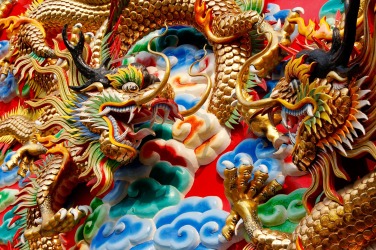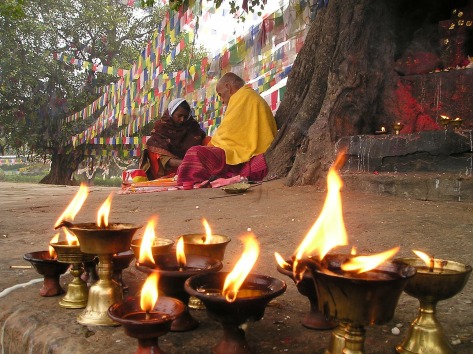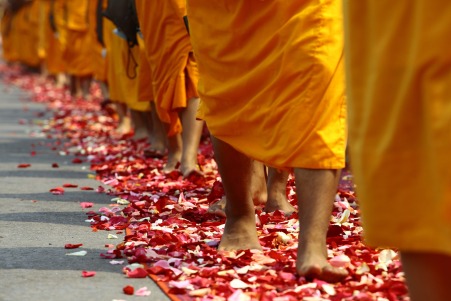A talk by Buddhist nun, Ani Lahmo, warns a small group of students that the teacher-student relationship in Buddhism is a serious business.
One September morning, a small group of around ten students gathered in a cosy shrine room, situated in a tall thin building that houses the Cardiff branch of the Buddhist Samye Foundation.
Though set back just a few meters from a busy road that runs through a bustling shopping district, no traffic sounds are audible in the shrine room, which is nestled in the attic. Decked out in the bright reds, golds, and royal blue of the Kagyu lineage, it is cushioned, peaceful, and smells, very lightly, of incense.
Ani Lahmo takes her seat on a circular velvet floor cushion that looks like an Indian milk sweet and lays her papers before her on a low wooden desk.
Shaven headed and wearing the distinctive carmine robes and yellow-gold blouse of a Tibetan Buddhist nun, Ani Lahmo is a young, slender, birdlike woman who speaks with a Scottish accent and puts her listeners at ease with her homely, self-effacing, and friendly manner.
It has been twenty-five years since Ani Lhamo became the secretary to her teacher, the distinguished and ever-cheerful Choje Lama Yeshe Rinpoche, Abbot of Scotland’s Kagyu Samye Ling monastery. Ani Lahmo is thus well-versed on what it means to be a student living within a Buddhist Order.
Her talk opens with the high importance placed on the teacher-student relationship in Buddhism.
Lineages, such as the Kagyu lineage, she explains, are dependent upon the wisdom and demonstrable skill of lineage holders. If teacher-student relationships break, or are ineffective, ‘the lineage is broken’.

Looking at us with concern, her expression conveys the serious nature of her talk this morning. It is directed at dedicated students, not spiritual tourists.
She makes it clear, the very integrity of the religion depends on the wise and correct pairing of student and teacher, and on a true and full commitment to the learning process.
The student’s own wellbeing also hangs in the balance, she tells the group. Even more reason for caution in choosing a teacher and taking the right attitude towards learning.
‘Some people have made serious changes to their lives, only to become disillusioned with their teacher. This can be a serious obstacle,’ says Ani Lahmo. Disturbingly, she warns that such mistakes can be ruinous.
After her talk, I am keen to speak to Ani Lahmo one-on-one, so, during the break I go and look for her.
I find her making a mug of hot water for herself in the tiny box of a kitchen down on the first floor. I stand in my bright white raincoat, seeming to fill the narrow doorway. Leaning against the doorpost in an effort to make myself smaller, I fear I’m impinging on her space, her quiet time, or breaking some unspoken hierarchical code.
But she is friendly and happy to talk. I ask her what became of the students who’d made the devastating mistake of upending their lives for the wrong guru.
Her answer surprises me. She says, in her experience, such students have gone on to become excellent practitioners and teachers of the Dharma. Their in-depth understanding of the pitfalls made them skilled guides, she says.
Returning to the attic, Ani Lahmo explains to the students that they must accept responsibility for the process of choosing a teacher.
I guess this must be because, in the event of things not turning out well, a student would have to look after themselves and could not do this if they effectively blamed someone else for any misfortune they had encountered.
Another danger is the leaping flame of admiration – becoming enamoured of a teacher and committing to them far to quickly and before they are fully known, trusted, and their methods fully understood.

To illustrate, Ani Lahmo compared a love-at-first-sight infatuation, which burns bright and ends quickly, to a long and successful marriage, which burns steadily over the course of many years. The latter is what the teacher-student relationship should emulate, she says.
Ani Lahmo also warns the group against teachers who exhibit crazy behaviour or demand high risk actions of their students.
It is unlikely, she says, that any teacher today could match the calibre of Tilopa. One of her lineage’s first teachers, Tilopa healed his student, Naropa, after the latter jumped off a cliff in response to a suggestion from his master.
These cautions out of the way, Ani Lahmo describes the three stages of a student’s journey:
1. Studying and reviewing a teacher
2. Following the advice of the chosen teacher
3. Emulating the teacher’s realisation
The first two stages are what Ani Lahmo calls the ‘getting to know you’ stage, prior to a student making a firm commitment to follow that teacher.
When studying a prospective teacher, Ani Lahmo lists some basic questions a student should ask themselves:
- Does he or she demonstrate absolute loving-kindness and compassion? And
- Does he or she exhibit no self-interest, but only concern for others and for the student’s wellbeing?
The only way to find answers to these questions, says Ani Lahmo, is to watch the teacher, and spend time with them ‘until you are satisfied’ – a process that can take several years.
One sign of a good relationship growing between teacher and student, is when the strength of feeling grows in the student towards their teacher, similar, again, to a healthy marriage.
However, there will be students who experience no such blossoming of devotion for their teacher. To those students, Ani Lahmo says not to worry: it is not important that devotion grows quickly, or even for a long time. What is important, she says, is that trust builds, even if slowly.
She offers a tip on this too: ask the teacher’s advice and then see if it works. This approach has the benefit of giving the student time to work on the relationship at their own pace.
‘If a teacher has both Compassion (the wish to help) and Wisdom (the capability to help), this is very precious,’ says Ani Lahmo of the kind of teacher a prospective student should be looking for.
Finally, coming to the qualities of a good student, Ani Lahmo says that once a teacher has been chosen and committed to, the student should not change their mind.
Students must be aware of their obligations and responsibilities. Says Ani Lahmo: ‘The teacher is only the facilitator. The student must do the work.’
‘The best offering you can make to a teacher,” she advises, is practice. ‘Apply the instructions so that you become a better person and diminish weaknesses.’

As a Buddhist, part of being a good student is being part of a community, and so a good student will promote harmony between others, between Dharma students, and especially between students of the same Order.
‘Like a belt, you should be a comfortable companion,’ she says, pointing at her own plain leather belt, which holds up her heavy cotton robes. And this includes, she says, being there for others when they need you and ‘melting away’ when you are no longer required.
You must even quietly take the blame for others, if need be. And you must do your work within the group, without the need for recognition or special treatment. Mixing in with the crowd ‘like salt’ in water, is essential in the Buddhist community, she says.
Recommended Reading:
Words of my perfect teacher, by Patrul Rinpoche
Purchase the book, here: https://www.amazon.co.uk/Words-Perfect-Teacher-Introduction-International/dp/0300165323



Very well analyzed and Beautifully written. Thank you my friend.
LikeLiked by 1 person
I like this post, enjoyed this one regards for posting.
LikeLiked by 1 person
Many thanks.
LikeLiked by 1 person